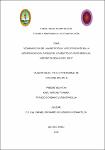| dc.contributor.advisor | Sologuren Anchante, Rafael Fernando | |
| dc.contributor.author | Vargas Ipanama, Karl | |
| dc.contributor.author | Vargas Padilla, Franco Giordano | |
| dc.date.accessioned | 2022-05-10T14:38:30Z | |
| dc.date.available | 2022-05-10T14:38:30Z | |
| dc.date.issued | 2022 | |
| dc.identifier.uri | https://hdl.handle.net/20.500.12737/7997 | |
| dc.description.abstract | The objective of the research was to compare a rotary system and a reciprocating system in the modification of the angle in curved ducts according to the Schneider method, 2021. The type of research was quantitative, the design was non-experimental, comparative descriptive, cross-sectional. The study was performed on 40 mesiobuccal canals of permanent mandibular first molars randomly assigned to either of the 2 groups, Mtwo rotary file; Reciproc Blue reciprocating file (20 teeth for each group). The instrument used was the data collection sheet for the angle of curvature of curved ducts. The most important results were: The average curvature angle of the group to be instrumented with Mtwo changed 1.7º; before instrumentation it was 28.25º and after it was 26.55º. The average curvature angle of the group to be instrumented with Reciproc blue changed 1.25º; before instrumentation it was 25.6º and after it was 24.35º. In the group to be instrumented with Mtwo, moderate curvature was 25%: severe was 75%; after instrumentation moderate curvature was 35%: severe was 65%. In the Reciproc blue group the slight curvature was 5%; moderate 40% and severe 55%; after instrumentation did not change. There is a significant difference between the angle of the curvature before and after the instrumentation with Mtwo (p=0.000). There is a significant difference between the angle of curvature before and after instrumentation with Reciproc blue (p=0.000). | en_US |
| dc.description.abstract | El objetivo de la investigación fue comparar un sistema rotatorio y un sistema reciprocante en la modificación del ángulo en conductos curvos según el método de Schneider, 2021. El tipo de investigación fue cuantitativa, el diseño fue no experimental, descriptivo comparativo, transversal. El estudio se realizó en 40 conductos mesiovestibulares de primeros molares inferiores permanentes asignados aleatoriamente a cualquiera de los 2 grupos, lima rotatoria Mtwo; lima reciprocante Reciproc Blue (20 dientes para cada grupo). El instrumento usado fue la ficha de recolección de datos para el ángulo de la curvatura de conductos curvos. Los resultados más importantes fueron: El promedio del ángulo de la curvatura del grupo a instrumentar con Mtwo cambió 1,7º; antes de instrumentar fue 28,25º y después fue 26,55º. El promedio del ángulo de la curvatura del grupo a instrumentar con Reciproc blue cambió 1,25º; antes de instrumentar fue 25,6º y después fue 24,35º. En el grupo a instrumentar con Mtwo la curvatura moderada fue del 25%: severa fue 75%; después de la instrumentación la curvatura moderada fue del 35%: severa fue 65%. En el grupo de Reciproc blue la curvatura leve fue 5%; moderada 40% y severa 55%; después de la instrumentación no cambió. Existe diferencia significativa entre el ángulo de la curvatura antes y después de la instrumentación con Mtwo (p=0,000). Existe diferencia significativa entre el ángulo de la curvatura antes y después de la instrumentación con Reciproc blue (p=0,000). | es_PE |
| dc.format | application/pdf | es_PE |
| dc.language.iso | spa | es_PE |
| dc.publisher | Universidad Nacional de la Amazonía Peruana | es_PE |
| dc.rights | info:eu-repo/semantics/openAccess | * |
| dc.rights.uri | https://creativecommons.org/licenses/by/4.0/ | * |
| dc.subject | Instrumentos dentales | es_PE |
| dc.subject | Diente | es_PE |
| dc.subject | Modificación | es_PE |
| dc.title | Comparación de lima rotatoria y reciprocante en la modificación del ángulo en conductos curvos según el método de Schneider, 2021 | es_PE |
| dc.type | info:eu-repo/semantics/bachelorThesis | es_PE |
| thesis.degree.discipline | Odontología | es_PE |
| thesis.degree.grantor | Universidad Nacional de la Amazonía Peruana. Facultad de Odontología | es_PE |
| thesis.degree.name | Cirujano Dentista | es_PE |
| dc.subject.ocde | https://purl.org/pe-repo/ocde/ford#3.02.14 | es_PE |
| renati.author.dni | 71690479 | |
| renati.author.dni | 70745187 | |
| renati.advisor.orcid | https://orcid.org/0000-0002-1632-0821 | |
| renati.advisor.dni | 21522076 | |
| renati.type | https://purl.org/pe-repo/renati/type#tesis | es_PE |
| renati.discipline | 911026 | es_PE |
| renati.level | https://purl.org/pe-repo/renati/level#tituloProfesional | es_PE |
| renati.juror | Chávez Paredes, Alejandro | |
| renati.juror | López Alama, Luis Enrique | |
| renati.juror | Carranza Del Águila, Raúl | |
| dc.publisher.country | PE | es_PE |


